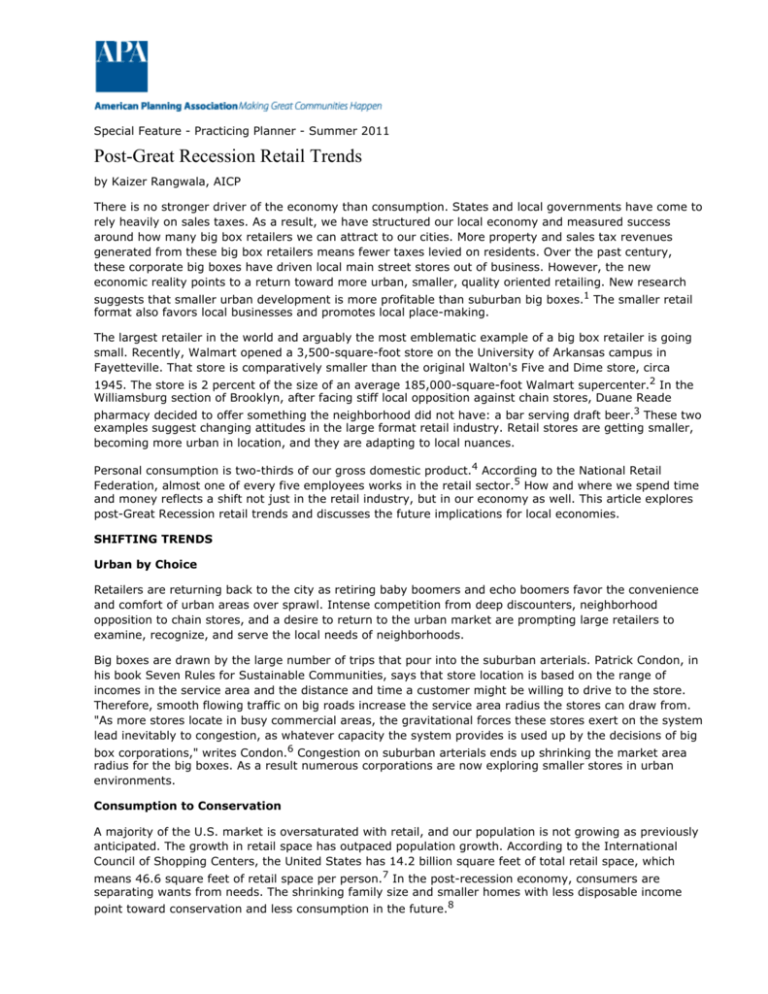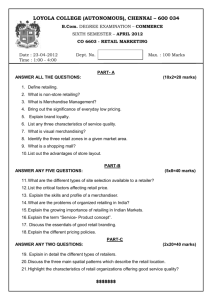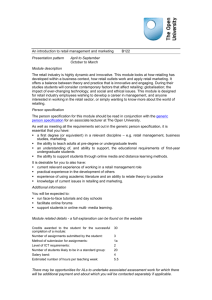
Special Feature - Practicing Planner - Summer 2011
Post-Great Recession Retail Trends
by Kaizer Rangwala, AICP
There is no stronger driver of the economy than consumption. States and local governments have come to
rely heavily on sales taxes. As a result, we have structured our local economy and measured success
around how many big box retailers we can attract to our cities. More property and sales tax revenues
generated from these big box retailers means fewer taxes levied on residents. Over the past century,
these corporate big boxes have driven local main street stores out of business. However, the new
economic reality points to a return toward more urban, smaller, quality oriented retailing. New research
suggests that smaller urban development is more profitable than suburban big boxes.1 The smaller retail
format also favors local businesses and promotes local place-making.
The largest retailer in the world and arguably the most emblematic example of a big box retailer is going
small. Recently, Walmart opened a 3,500-square-foot store on the University of Arkansas campus in
Fayetteville. That store is comparatively smaller than the original Walton's Five and Dime store, circa
1945. The store is 2 percent of the size of an average 185,000-square-foot Walmart supercenter.2 In the
Williamsburg section of Brooklyn, after facing stiff local opposition against chain stores, Duane Reade
pharmacy decided to offer something the neighborhood did not have: a bar serving draft beer.3 These two
examples suggest changing attitudes in the large format retail industry. Retail stores are getting smaller,
becoming more urban in location, and they are adapting to local nuances.
Personal consumption is two-thirds of our gross domestic product.4 According to the National Retail
Federation, almost one of every five employees works in the retail sector.5 How and where we spend time
and money reflects a shift not just in the retail industry, but in our economy as well. This article explores
post-Great Recession retail trends and discusses the future implications for local economies.
SHIFTING TRENDS
Urban by Choice
Retailers are returning back to the city as retiring baby boomers and echo boomers favor the convenience
and comfort of urban areas over sprawl. Intense competition from deep discounters, neighborhood
opposition to chain stores, and a desire to return to the urban market are prompting large retailers to
examine, recognize, and serve the local needs of neighborhoods.
Big boxes are drawn by the large number of trips that pour into the suburban arterials. Patrick Condon, in
his book Seven Rules for Sustainable Communities, says that store location is based on the range of
incomes in the service area and the distance and time a customer might be willing to drive to the store.
Therefore, smooth flowing traffic on big roads increase the service area radius the stores can draw from.
"As more stores locate in busy commercial areas, the gravitational forces these stores exert on the system
lead inevitably to congestion, as whatever capacity the system provides is used up by the decisions of big
box corporations," writes Condon.6 Congestion on suburban arterials ends up shrinking the market area
radius for the big boxes. As a result numerous corporations are now exploring smaller stores in urban
environments.
Consumption to Conservation
A majority of the U.S. market is oversaturated with retail, and our population is not growing as previously
anticipated. The growth in retail space has outpaced population growth. According to the International
Council of Shopping Centers, the United States has 14.2 billion square feet of total retail space, which
means 46.6 square feet of retail space per person.7 In the post-recession economy, consumers are
separating wants from needs. The shrinking family size and smaller homes with less disposable income
point toward conservation and less consumption in the future.8
Income Concentrated at the Top
The U.S. middle class is shrinking, with the rich getting richer. In the post-recession economy, the poor
and middle class have less disposable income to spend on consumption. Robert Reich in his book,
Aftershock, indicates the middle class lacks purchasing power to buy what the economy can produce. The
top 1 percent who control over one-fourth of the nation's wealth continue to spend their money on
speculation — not retail goods.9
Economics of Plenty
Online retail offers near limitless choices. Companies like Amazon.com have virtual inventory — products
stored in warehouses and only displayed on the unlimited shelves online. The "long tail" of online retailing
offers virtually unlimited variety besides the mainstream brick-and-mortar rental stores with filters and
recommendations to make informed purchases.10 Providers of goods on the Internet have captured the
market in books, electronics, linens, and pet supplies, and the list continues to grow.
Online retailing begins to level the playing field by making it easy for small mom-and-pop stores to
compete head-on with big-box retailers. Online retailing stretches beyond the physical location of the
store, allowing main street retailers to reach a wider audience. Small stores may have an advantage. Their
size makes them nimble and easy to adapt to market changes without approvals that big boxes typically
need from their parent corporations.
Human Scale
The big boxes have come to symbolize the standardization, mass production and distribution, and
specialization of the modern retail industry. Increasingly, large corporations (parents of many big boxes)
are taking a beating on Wall Street and Main Street, and are either shrinking or closing down.11 Walmart
Market Stores, CityTarget and Best Buy Mobile stores are some of the smaller urban store formats being
pursued by large format retailers.12 Small independent retailers, those that carry less risk and are more
nimble to market shifts, continue to grow; despite the large number of failures, many survive and grow.
The more personal and local retail is, the more likely it is to provide a more intimate and richer shopping
experience. Shrinking city and personal budgets will have cities and consumers favoring local retail that
keeps a larger share of the dollar circulating within the community, instead of large corporations that tend
to move wealth out of the community. The implications of this new retailing trend may include more
human-scaled and walkable urban physical environments, such as more engaging storefronts, wider
sidewalks, and streets designed for people as well as cars.
THE FUTURE
The trends in retailing may prompt a complete devolution of the big box into smaller specialized Main
Street-type retail shops.
The word retail is derived from the French word "retaillier," meaning to cut a piece off or to break bulk.13
Retailing is therefore a process or system by which large quantities of goods are broken down and
repackaged into a form that is readily usable by the end consumer. The process involves manufacturing,
wholesaling, and finally, retailing.
Online sales, also known as "e-tailing,"14 along with catalog and television sales bring the manufacturer or
wholesaler directly to the consumer. The intent has been to eliminate the retailers and thus secure more
profits. Consumers are using their purchasing power to push retailers to provide better merchandise,
better shopping experiences, and convenience that is not easily found in big box stores or provided with
impersonal technology.
Retailers are catching on that the "more is better" approach backfires. Less and small may be better than
more and big. Emily Nelson in a Wall Street Journal article quotes Mark Lepper of Stanford University, who
studied customer preferences and concluded that "people feel bad when choosing from a broad selection
because they second-guess their pick and worry they have made a poor selection."15
What Happens to Big Boxes?
A recent study conducted by Sarasota County found that compact urban development produces more sales
and property tax compared to sprawling big box retail development. To sustain big boxes in tough times
will require higher subsidies than cash-strapped cities may be willing to offer.16 Some of the big boxes
occupy key sites along freeways. If big boxes go out of business, cities will have a unique opportunity to
examine the deficiencies and transform the sites by creating walkable block and street structures,
attracting mixes of land uses, and better connecting the center to the surrounding area.
CONCLUSION
Consumers want value, but not at the expense of personal and community values as they relate to
sustainability, authentic experience, and social responsibility. Small Main Street retailers should emphasize
local identity, quality merchandise, and social experience.
The small urban store is more likely to be owned and operated locally; support local production, purchase,
and consumption; retain a larger share of the profits within the local economy; reduce vehicle miles
traveled, greenhouse gas emissions, and energy consumption; and support sustainable and vibrant
urbanism.
The crisis of the great recession has changed our consumer behavior. In this change is a tremendous
opportunity for planners and economic developers who know where the economy is headed. As
consumers, we can bring greater value to our lives by reconnecting with retailers that share our beliefs.
Together, we can reconstruct our economy to be creative and restorative rather than destructive.
Kaizer Rangwala is the founding principal of Rangwala Associates, a town planning firm that practices the
principles of smart growth and walkable urbanism. He has lectured extensively on smart growth, new
urbanism, form-based codes, and regulatory reform at planning conferences, planning schools, and at the
Form-Based Codes Institute, where he also serves as the organization's chairman. He holds a master's in
architecture from New Jersey Institute of Technology, a master's in city and regional planning from
Rutgers University, and a certificate in Economic Development from the Economic Development Institute
at Oklahoma University.
NOTES
1 "Best Bet for Tax Revenue: Mixed-use Downtown Development." New Urban News, 15, 6: 1-5.
2 Talley, Karen. 2010. "Walmart Takes Small-Store Concept to Maximum Degree. The Wall Street Journal,
December 22.
3 http://www.nrf.com/modules.php?name=pages&sp_id=1242. Accessed on May 7, 2011.
4 Hale, Stewart. 2010. "A Closer look at the G.D.P." New York Times, December 16.
5 http://www.nrf.com/modules.php?name=pages&sp_id=1242. Accessed on May 7, 2011.
6 Condon, Patrick. 2010. Seven Rules for Sustainable Communities: Design Strategies for the Post-Carbon
World. Washington, D.C.: Island Press.
7 http://www.icsc.org/srch/faq_category.php?cat_type=research&cat_id=3. Accessed on May 7, 2011.
8 U.S. Census Bureau. November 10, 2010. "U.S. Census Bureau Reports Men and Women Wait Longer to
Marry." Press Release.
9 Reich, Robert. 2010. Aftershock: The Next Economy and America's Future. Knopf.
10 Anderson, Chris. 2006. The Long Tail: Why the Future of Business Is Selling Less of More. New York:
Hyperion.
11 Hudson, Kris and Miguel Bustillo. 2011. "Malls Face Surge in Vacancies: Fallout From Boom and
Downturn, Change in Habits, Hit Local Shopping Areas." Wall Street Journal, April 7.
12 Misonzhnik, Elaine. 2011. "Big-Box Giants Downsize to Drive Productivity with Smaller Urban Stores."
Retail Traffic, March 30.
13 http://en.wikipedia.org/wiki/Retailing.
14 http://dictionary.reference.com/browse/e-tailing.
15 Nelson, Emily. 2001. "Too Many Choices — Nine Kinds of Kleenex Tissue, Eggo Waffles in 16 Flavors:
Blame Brand Managers." The Wall Street Journal, April 20.
16 Ibid.
RECOMMENDED READING
Coyle, Stephen. 2011. Sustainable and Resilient Communities: A Comprehensive Action Plan for Towns,
Cities, and Regions. New York: John Wiley and Sons, Inc.
Gerzema, John, and Michael D'Antonio. 2010. Spend Shift: How the Post-Crisis Values Revolution Is
Changing the Way We Buy, Sell, and Live. Jossey-Bass.
Mouzon, Stephen. 2010. The Original Green: Unlocking the Mystery of True Sustainability. The New Urban
Guild Foundation.
Shell, Ellen Ruppel. 2009. Cheap: The High Cost of Discount Culture. New York: Penguin Press.
Tachieva, Galina. 2010. Sprawl Repair Manual. New York: Island Press.
©Copyright 2011 American Planning Association All Rights Reserved









